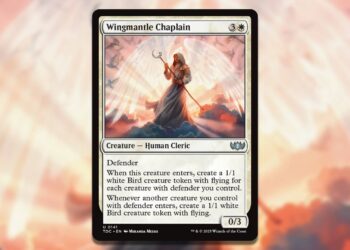Historically, blue has been considered the weakest color in terms of combat in Magic: The Gathering. The prevailing view was that blue’s spellcasting prowess made combat less crucial, so blue creatures mostly provided support rather than engaging directly in battles.
However, as Magic evolved to become more combat-oriented, Wizards of the Coast sought to enhance blue mages’ competitive edge through the introduction of prowess—a special ability that boosts a creature’s power whenever a player casts noncreature spells. This guide will explain how prowess works and offer strategies to maximize its potential.
Understanding Prowess
Prowess is an ability that activates whenever you cast a noncreature spell. It grants the creature with prowess a temporary boost of +1/+1 until the end of turn.
The specific wording is: “Whenever you cast a noncreature spell, this creature gets +1/+1 until end of turn.“
Prowess can only be found on creatures, as its effects only apply to them. This ability is typically present on red, white, or blue creatures, having first debuted with the Jeskai Way faction in Khans of Takir.
Since its introduction, prowess has emerged as a highly sought-after keyword, offering blue creatures an effective combat tactic. Cards that allow for drawing spells like Brainstorm or Ponder can translate into significant power increases for prowess creatures.
This ability shines particularly well when combined with instant spells, though prowess will activate with any noncreature spell. This includes enchantments, artifacts, planeswalkers, battles, and sorceries.
Note that enchantment creatures or artifact creatures will not trigger prowess. The spell must not have the word creature in its type at all. Also, prowess will only activate once per spell, even if that spell has multiple noncreature types.
Maximizing the Potential of Prowess
Casting multiple spells triggers prowess multiple times, allowing for a substantial power increase. This makes prowess particularly effective in decks with fewer creatures but a greater number of inexpensive spells that can draw more cards.
Brainstorm, Opt, Gitaxian Probe, and Consider are excellent options to utilize alongside creatures with the prowess keyword. While sorceries such as Peek, Ponder, Preordain, Portent, and Serum Visions are often less effective in combat since they cannot be used as instant tricks, they still provide a boost to prowess creatures before combat occurs.
Holding onto several of these low-cost spells—often referred to as cantrips—can allow you to enhance the power of a prowess creature just before using Slip Through Space or Enter the Enigma, rendering it unblockable. This can make for a shocking play for your opponent.
Another effective strategy is to make prowess the centerpiece of an infinite combo. The combo does not need to achieve anything beyond casting a noncreature spell infinitely to grant a prowess creature infinite power and toughness until the end of the turn.
One possible combo involves Retraction Helix, Zephyr Scribe, and any zero-cost artifact. You can repeatedly bounce and replay the artifact to accumulate whatever power and toughness you desire for your prowess creature.
Prowess is unique in that it stacks. If a creature possesses prowess multiple times, each instance triggers separately. For instance, if Monastery Swiftspear is in play while Bria, Riptide Rogue is on the board, casting Brainstorm will give Monastery Swiftspear a +2/+2 boost until the turn ends.
It is also important to note that prowess isn’t the only ability that activates with noncreature spells. Cards like Murmuring Mystic, Sprite Dragon, Third Path Iconoclast, and Guttersnipe add great value to non-creature spell-focused decks.
Prowess works especially well with spells that have flashback abilities, allowing you to effectively cast the same spell again.
Top Cards Featuring Prowess
Currently, there are 73 cards with prowess in Magic. While it’s impossible to cover every card, we can highlight a few standout options.
Several creatures were previously noted, but Monastery Mentor, Harmonic Prodigy, and Soul-Scar Mage all deserve recognition. Monastery Mentor generates tokens, Harmonic Prodigy doubles triggered abilities (including prowess), and Soul-Scar Mage pairs exceptionally well with burn spells.
Monastery Swiftspear is often the cornerstone of prowess decks due to its efficiency. Bedlam Reveler is useful when your hand runs low, and Elsha Of The Infinite can be a powerful commander choice.
However, Bria, Riptide Rogue from the Bloomburrow expansion is perhaps even better. This Otter Rogue can double prowess triggers while also enabling a creature to become unblockable. Narset, Enlightened Exile performs a similar function, doubling prowess triggers and allowing you to cast noncreature spells from your graveyard.
Two uncommons worth mentioning are Curious Homunculus, which generates mana for instants and sorceries, eventually transforming into Voracious Reader, a larger prowess creature that reduces the cost of instants and sorceries. Stormcatch Mentor also lowers the cost of sorceries and instants while having both prowess and haste.
Finally, while Ral, Crackling Wit is not a creature with prowess, his planeswalker ability generates 1/1 blue and red Otter tokens that possess prowess. He offers several other useful abilities for any prowess-themed deck.







